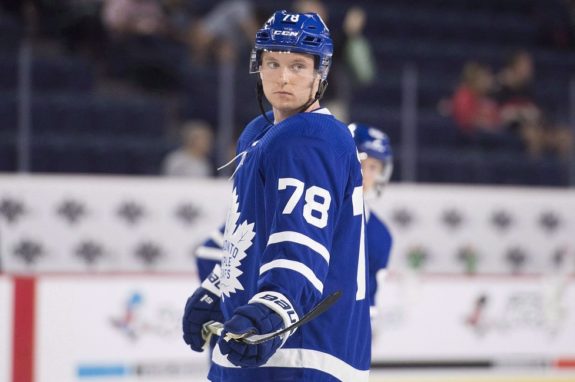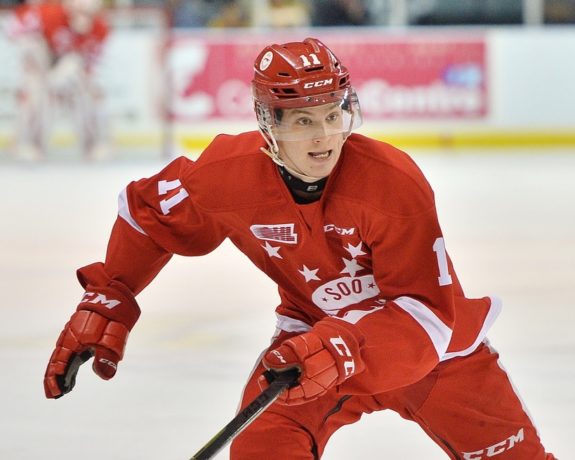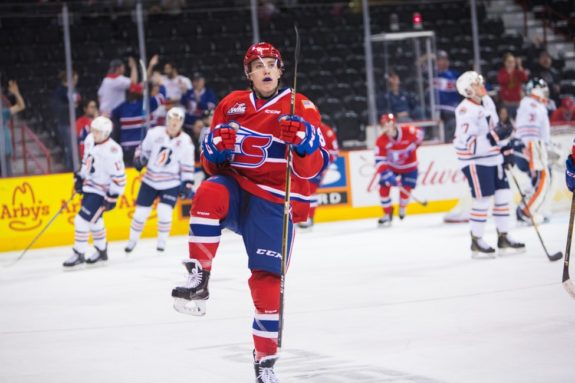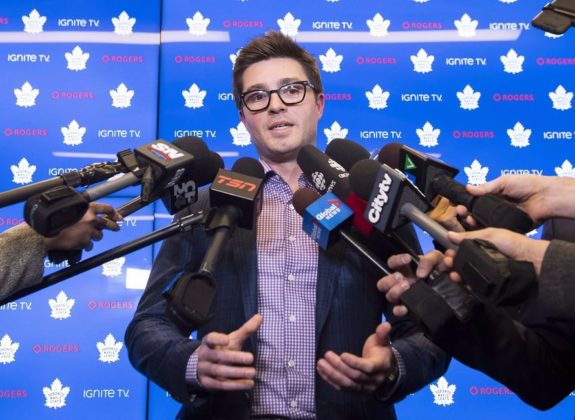With the 2019 NHL Entry Draft just around the corner, let’s take a look back at last year’s draft to get an idea of what could be in store this time around. Kyle Dubas’ first season as general manager of the Toronto Maple Leafs is now in the rear-view mirror and we have had a full season to look at the progress of his first draft class.
The hope of this exercise is to get an idea of Dubas’ draft patterns as well as get a progress report on the youngest players in the Maple Leafs’ system.
Rasmus Sandin (First Round, 29th Overall)
The consensus is that Sandin has supplanted Timothy Liljegren as the top prospect in Toronto’s system. He is described as a cerebral defenseman who uses his spacial awareness and decision-making to control the puck. At 5-foot-11 and 187 pounds, the left-handed defenseman isn’t known for his physical play but uses his positioning to leverage every inch of his frame.
The 19-year-old Swede was able to jump straight to the AHL and flourish. Sandin produced 28 points in 44 games with the Toronto Marlies, while gaining more assignments and special team responsibilities as the season progressed. He missed some time due to an elbow sprain but didn’t seem to miss a beat upon returning.

As a former Sault Ste. Marie Greyhound, there was some familiarity between Dubas and Sandin. The Maple Leafs actually traded down from the 25th pick because they were sure that their man would still be available at pick 29. The early returns look promising as Sandin will compete for an NHL job as early as next season. Dubas’ first official pick as Toronto’s general manager has the makings of a steal from the 2018 Draft.
Sean Durzi (Second Round, 52nd Overall)
This season Durzi turned heads after the Guelph Storm acquired the young right-handed defenseman from the Owen Sound Attack in January. He accumulated 37 points in 35 OHL regular season games and his 27 playoff points were instrumental to Guelph’s run to win the J. Ross Robertson Cup as the 2019 OHL champions. He was also named to the 2019 Memorial Cup All Star team.
Durzi’s bread and butter is his ability to move the puck and join the rush which are valuable tools in today’s NHL. Whether that translates to the next level will depend on his ability to adjust to the speed and physicality of the professional levels.
The 2018-19 season boosted Durzi’s stock as a legitimate NHL prospect. The Maple Leafs felt that they sold high when they traded him to Los Angeles in a package deal that netted highly sought-after defenseman Jake Muzzin.
Trading Durzi may come back to haunt Toronto, but minute-eating defensemen with term on their contract, such as Muzzin, don’t come without a steep price.
Semyon Der-Arguchinstev (Third Round, 76th Overall)
Der-Arguchinstev was the youngest player taken in last year’s draft. He was a third-round pick that the Maple Leafs got from the St. Louis Blues when they traded down to draft Sandin at pick 29.
Der-Arguchinstev saw a dip in scoring this season. His 46 points in 62 games with the OHL’s Peterborough Petes is nothing to sneeze at, but he only scored six goals a season after tallying 12 in his draft year. The 5-foot-11 center has a tonne of upside and skill for a third-round pick.
The young Russian will have to pack on some muscle if he hopes to make the jump to the next level. The margin of error for a mid-round, under-sized, pass-first center is razor thin.
I am most intrigued by Dubas’ use of their ECHL affiliate as a development tool. Amidst their run to the 2019 Kelly Cup, Der-Arguchintsev was called up and played three regular season games and nine playoff games for the Newfoundland Growlers. The Growlers should give Maple Leafs prospects an excellent opportunity to cut their teeth on the rigours of professional hockey.
Riley Stotts (Third Round, 83rd Overall)
Stotts enjoyed another strong WHL season in 2018-19. He scored 19 goals and 57 points in 62 games while seeing his role increase with the Calgary Hitmen. He profiles as a middle-six forward with a potentially strong two-way game despite a slighter frame. Similar players in the Maple Leafs’ system like Trevor Moore and Adam Brooks offer a potential blueprint to Stotts’ path to the professional level.
Here’s what Ryan Pike of The Hockey Writers had to say about Stotts last summer:
In a lot of ways, Stotts is an ideal “middleweight” player. He’s not a big player but he’s not small, nor does he get pushed around a lot. He’s mobile, but he’s not a speedster. He’s good with the puck, but he doesn’t usually dazzle with stick-handling – though he is capable of maneuvering past defenders. You could argue that he doesn’t have a single elite-level attribute, and you’d probably be right, but Stotts’ game is more than the sum of its parts. He works extremely hard, is rarely out of position, and frequently makes his teammates better whether by making a smart defensive play to close off a passing lane or taking the time to wait for holes in defensive coverage to find a teammate.
“Riley Stotts – 2018 NHL Draft Prospect Profile” by Ryan Pike (5/12/2018)
Mac Hollowell (Fourth Round, 118th Overall)
In the fourth round of the draft, Dubas took his second Greyhound of the night, Mac Hollowell. The offensive defenseman dropped in the draft because of a slight frame listed at 5-foot-10, 170 pounds. He is a big talent in a small body and Dubas trusted the intel from his former team in Sault Ste. Marie.
This was Hollowell’s first season as “the man” on the Greyhounds’ blue line and he did not disappoint. His 24 goals and 77 points in 64 regular season games earned him a spot on the OHL’s First All-Star team for the 2018-19 season.

This spring, the Marlies called Holloway up in the middle of their playoff run and he was able to grab hold of a spot on the last pairing. His strong play earned him the trust ofMarlies coach Sheldon Keefe,
“He found a way to make complicated situations look simple, which is really what you’re looking for, so that was really good for him. And defensively, he was really good with his gaps and didn’t hurt us at all. It was very encouraging, and that’s why we’ve remained confident in playing him.”“
“Why Mac Hollowell is becoming a Maple Leafs right shot to watch” by Luke Fox (5/16/2019)
While size is Hollowell’s biggest detractor, you can move up the ranks so long as you keep producing. Just ask 5-foot-9 Torey Krug who went from being an undrafted college free agent to a major player on for the Boston Bruins who are playing for the Stanley Cup.
Filip Kral (Fifth Round, 149th Overall)
At 6-foot-one, Kral is the tallest skater that the Maple Leafs selected in last year’s draft. He fits Dubas’ draft theme as a mobile, puck-moving defenseman, which added further depth to a position of need for the team.
Kral had 36 points in 47 games for the WHL’s Spokane Chiefs, showing his knack for play-making. He made the Czech Republic’s World Junior squad last year and chipped in with one goal in five games.

Kral has upside, but of the three defensemen drafted by the Maple Leafs in 2018, he is probably the weakest in his own end. The 19-year-old will have to iron out the kinks in his game in order to advance in a Maple Leafs system that seems to get more crowded by the day.
Pontus Holmberg (Sixth Round, 156th Overall)
Dubas sees something in Holmberg, considering he traded the team’s 2019 sixth-rounder to the Buffalo Sabres in order to acquire this pick. The small center is considered a high-upside pick but will be more of a long-term project.
In his first full season in the Swedish Hockey League, Holmberg had 10 points in 47 games for the Vaxjo HC. At 19 years old, he was one of the youngest players on a team full of grown men. Former NHLers Viktor Fasth and Kris Versteeg were his teammates and he also played alongside 2018 first-round pick Dominik Bokk.
You’d think that the Leafs would want him to develop in their own system in North America, but considering how crowded the Marlies’ forward depth seems to be, the SHL should be a comfortable spot for Holmberg to acclimatize to professional hockey in his home country.
Seventh Rounders: Zachary Bouthillier & Semyon Kizimov
Bouthillier is considered a bit of a late-round flier as far as goalie prospects go. At mid-season he was traded to a lowly St. John Sea Dogs team that went 13-49-0-6. In 18 games with the Sea Dogs, Bouthillier sported a 5.13 GAA and a .822 save percentage. These numbers are likely the byproduct of playing behind a poor team, considering Bouthillier had a 3.36 GAA in 22 games with the Chicoutimi Saguenéens before the trade. At season’s end, Bouthillier signed with the ECHL’s Newfoundland Growlers.
As far as their other seventh-rounder, Kizimov is a gamble that plays for the Lada Togliatti of the VHL (the feeder league to the KHL). The right winger is a project, but as a Russian prospect, the Maple Leafs own the NHL rights to Kizmov indefinitely. There’s plenty of time to see what this guy can become.
What to Watch For in 2019
Given the sample size of his first nine draft picks as an NHL general manager, there are two trends from 2018 that define Dubas’ draft style. One, he loves players who can play the game at a high pace. That doesn’t necessarily mean he likes fast players–one of Sandin’s knocks coming out of the draft was his skating ability–but rather he likes players who can think the game at a high pace and execute.
The second trend to watch, is Dubas’ penchant for identifying players who fall in the draft due to a perceived lower prospect pedigree. Durzi went undrafted in the 2017 draft, Sandin had only played one season in North America prior to 2018 and Stotts was coming off a breakout season after playing a depth role in the 2016-17 season.

As the Maple Leafs’ young core become more expensive, the ability to identify talent in the draft will be even more important. If Dubas can hit the mark and surround Auston Matthews and co. with high-end talent on cheap rookie contracts, it will do wonders to help them fit under the salary cap and extend their window as contenders. Some call it the “Chicago model”, but Dubas has already shown that he does things his own way.